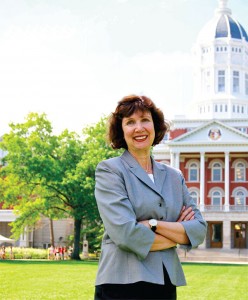Plan To Grow

 The secret behind the University of Missouri’s ever-growing student population is a plan. In 2001, Chancellor Richard Wallance and Provost Brady Deaton asked Ann Korschgen, vice provost for enrollment management, to devise an enrollment management plan. When the plan was put in place in 2002, the student population was around 24,000.
The secret behind the University of Missouri’s ever-growing student population is a plan. In 2001, Chancellor Richard Wallance and Provost Brady Deaton asked Ann Korschgen, vice provost for enrollment management, to devise an enrollment management plan. When the plan was put in place in 2002, the student population was around 24,000.
“Essentially the plan was that we would grow steadily and that we would increase our minority enrollment and increase our out-of-state enrollment and try to maintain and increase our high-ability students,” Korschgen says. “Ever since that time, we have been working on achieving those goals, and we have.” Now the MU population has increased to almost 35,000, a difference of nearly 11,000 students.
Korschgen gives three reasons why the university wanted more growth. “One is because larger universities have greater stature, typically, and greater impact,” she says. Universities with a large student body have more of a national presence with sheer size and the number of alumni. The second reason is the number of Missouri high school graduates is dropping. “We knew that if we didn’t do something about it, our enrollment would start to decline.” Korschgen dedicated part of the plan to help deal with the shrinking number of grade school and high school students. Third, the university was not receiving as much state support as before, and increasing student enrollment was a way to increase revenue and keep it stable.
The enrollment management plan uses strategies to recruit all types of students: out-of-state, low-income, international, transfer, minority and high-ability students. One of these strategies is to use recruitment materials that are state of the art. In fact, these materials are award winning. In 2011, the publications received the CASE bronze award for Publications Program Improvement, and the viewbook received a Best of Show award from Higher Ed Marketing Report.
In addition, MU wants to make sure the students and their families have the best customer service from recruiters in their cities and from tour guides when they come to Columbia. The university receives good reviews when prospective students come to tour the campus. “So many, many families say that the visit to Mizzou is the very best they’ve had in terms of all their campus visits,” Korschgen says.
Demographic decline
In doing research for the enrollment management plan, the team assigned to the project discovered some startling information. “In terms of our demographic decline, between the years 2010 and 2014, there will be a drop of 9,000 high school graduates in the state of Missouri,” Korschgen says. “And then even by 2022, the number of high school graduates is significantly lower than it was in 2010.” The university is already seeing the impact of the lack of high school graduates. In the past two years, the number of students from Missouri has declined some. As a result, the number of out-of-state students has increased significantly.
“We’re doing all we can to recruit in Missouri, so we’ve never backed off in recruiting; it’s just the numbers,” Korschgen says. Other flagship universities in other states are experiencing the same phenomenon, so the competition for out-of-state students has become even greater.
“I don’t think people were aware of how dramatic it would be, and once we started gathering the data and sharing with others, I think people were surprised at what’s ahead,” Korschgen says. “Some schools have not done a whole lot to prepare for it, but I would say we’ve maximized our opportunities to ensure that we would have a stable, if not growing, enrollment.”
Diversity enrollment
When Korschgen began working for the university, people were concerned with the decline of African-American enrollment. To help with this problem, she met with the legislative black caucus as well as guidance counselors from the inner city in St. Louis. The solution was to bus in high school students to check out the campus. Since then the number of African-American students has increased, and the university has hired a diversity recruiter. Korschgen says the university is setting records for the number of Hispanic students enrolled, too.
This past fall, Korschgen realized there needed to be an international effort in addition to the other strategies. Thus, an international recruitment plan was enacted, and an assistant director of international recruitment was hired. “We’re targeting international countries where we know there’s a growing middle class where they have the financial wherewithal to send their children abroad and where the economy’s stable,” she says. “So we’re looking at countries like Brazil and Turkey, Indonesia and so on as well as China and Korea.” Already, the university is seeing an increase in the number of international students coming to MU.
Out-of-state students and transfer students
To attract more students outside of Missouri, the university sent recruiting materials to the Chicago area and went to college fairs. Once MU established a presence in Chicago, it enlisted the help of two full-time recruiters from the area in 2003. Now the university has recruiters in Dallas, Minneapolis and Denver, and as result, the number of nonresident students has increased by 77 percent since 2003. There are recruiters throughout Missouri as well, and because of this effort in Missouri, the in-state student population has increased by 19 percent since 2003.
In 2005, the university hired a full-time recruiter who goes to all the community colleges in Missouri. Korschgen says the recruiter has had many articulation agreements from community colleges to make the transfer process to MU easier. The previous year, Korschgen began hosting community college presidents on campus to speak with them about concerns they might have in transferring their students. This tradition is now in the hands of Terry Barnes, assistant provost for community college partnerships.
High-ability students and low-income students
The number of high-ability students has increased as well. Since 2002, the number of those with an ACT score of 33 or better or a combined critical reading and math SAT score of 1440 or higher has risen by 137 percent. One reason for this was the result of introducing a new scholarship for high-ability students called the Mizzou Scholars Award, which is given to 10 students each year. The Mark Twain Award also had its criteria expanded and has helped growth.
In addition, MU has seen an increase in the number of low-income students due to the strategic plan. This year, those who are eligible to receive Pell Grants comprise 27 percent of students. The year before, it was lower at 23 percent. In just one year, the university has seen an increase of 5 percent of these students.
Korschgen says the university is giving a lot of financial aid to help students with their costs. “This year we’re giving out in our own money, the institution money, $44 million in institutional funds for aid,” she says. “That’s a $5 million increase from last year, and that doesn’t include endowed scholarships.” Including endowed scholarships would give the total another $2.7 million.
MU’s undergraduate students — 70 percent of them — will receive financial aid this year. “That’s a lot of money coming into the Columbia area,” Korschgen says because students from the university spend “$1 million to $2 million a day, or about $500 million during the academic year, not including tuition.
As a result, Columbia’s economy has a lot to do with the university and the number of students it brings in, especially when the number of students enrolled at MU has risen 34 percent in 10 years. “It’s staggering when you really look at it,” Korschgen says.
Korschgen says MU is the fastest-growing institution in the AEU, and it’s all because of a plan. “I think that’s what people need to know, that this is a plan to grow,” she says. “It’s not a surprise but intended all along, and we’ve grown exactly how we’ve wanted to grow with high-ability, diverse, successful students.”


